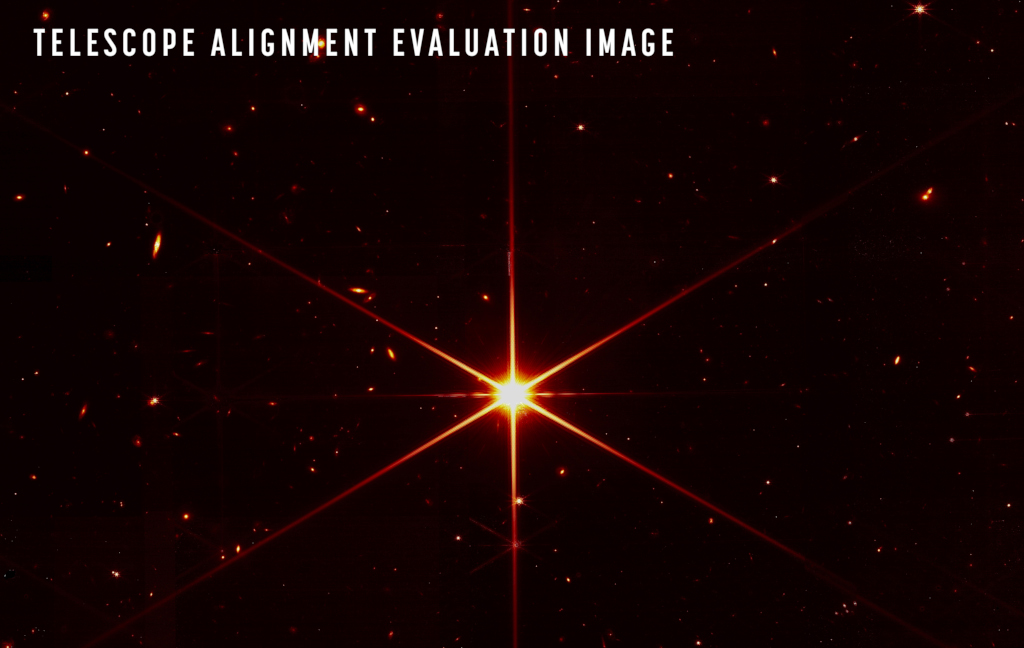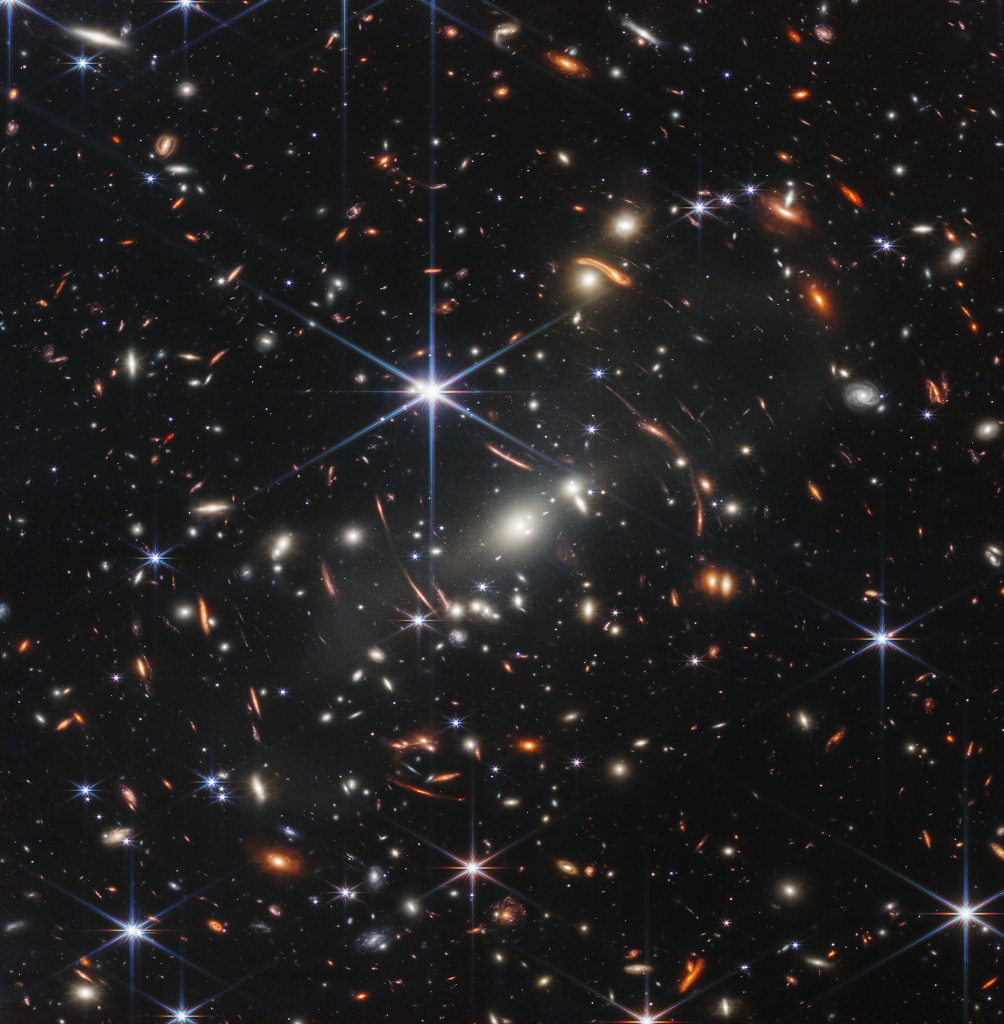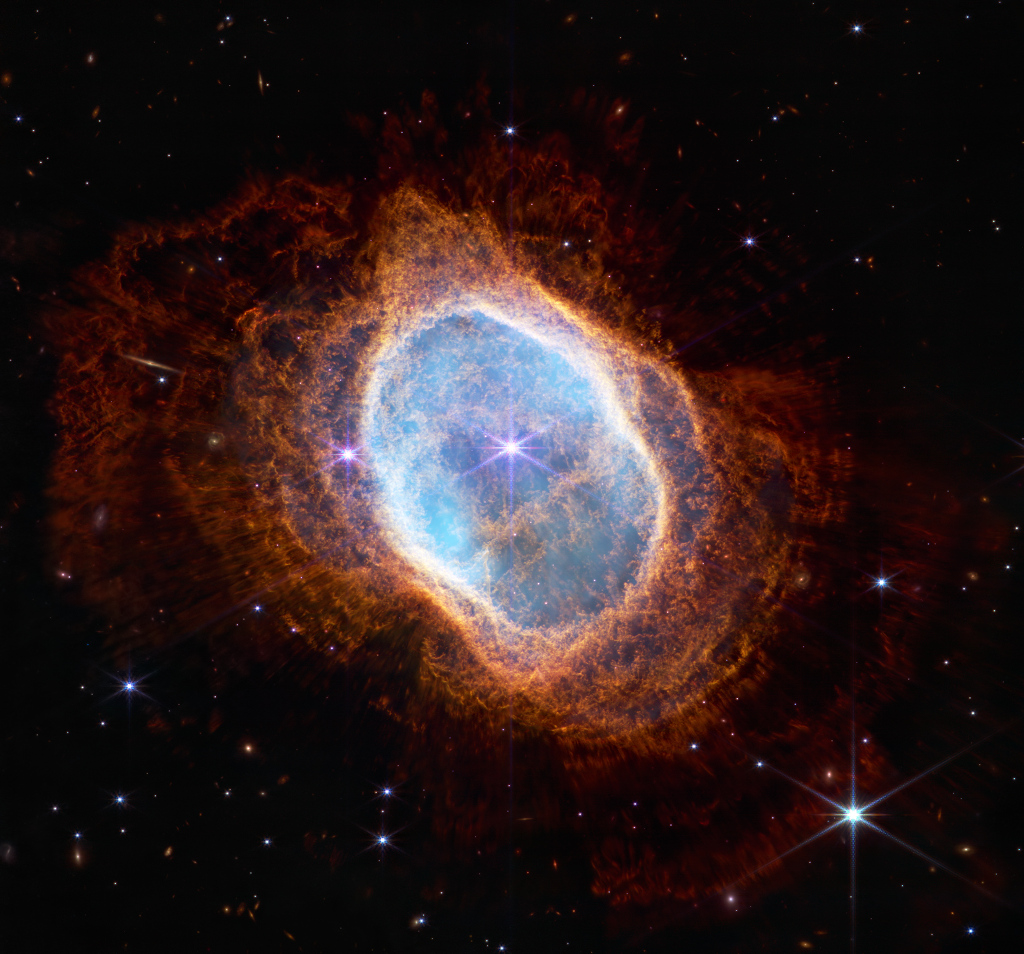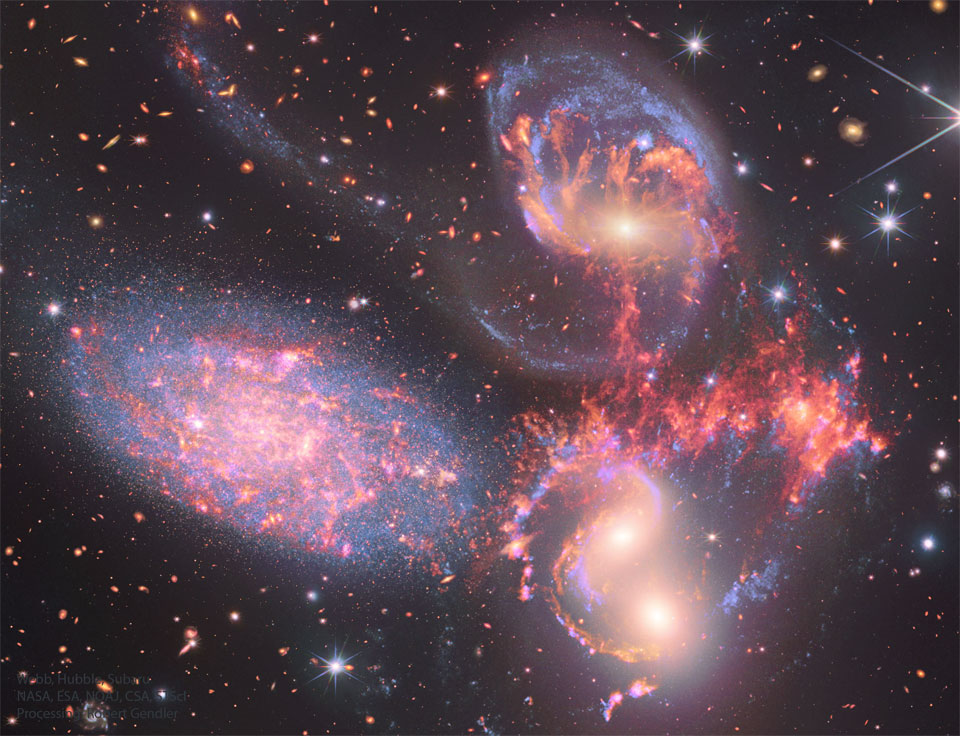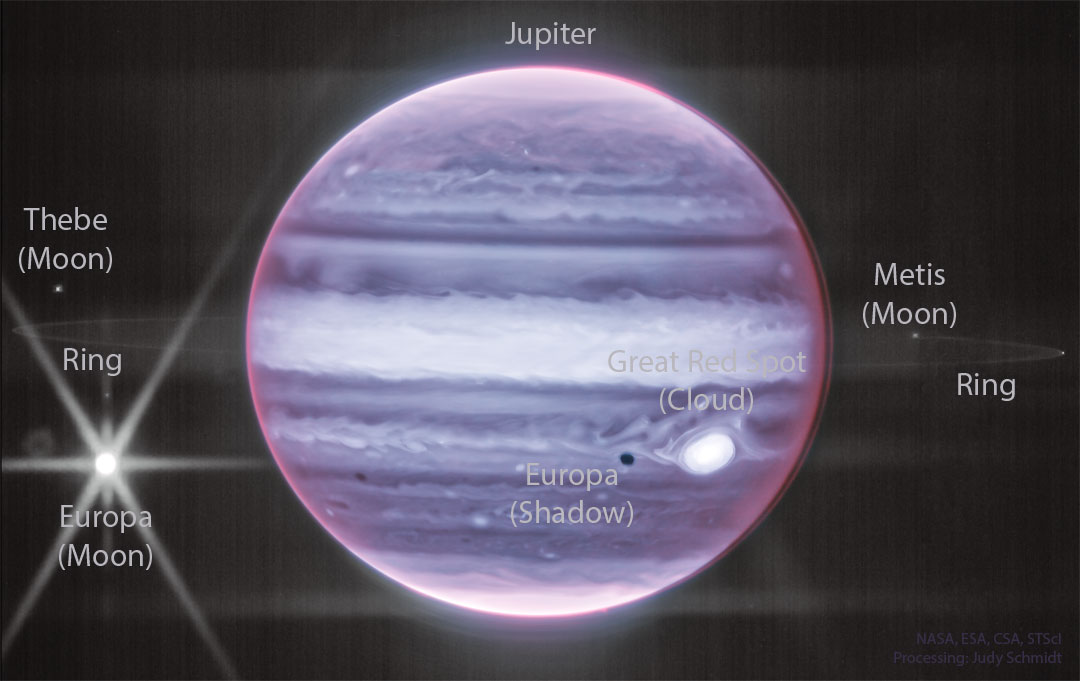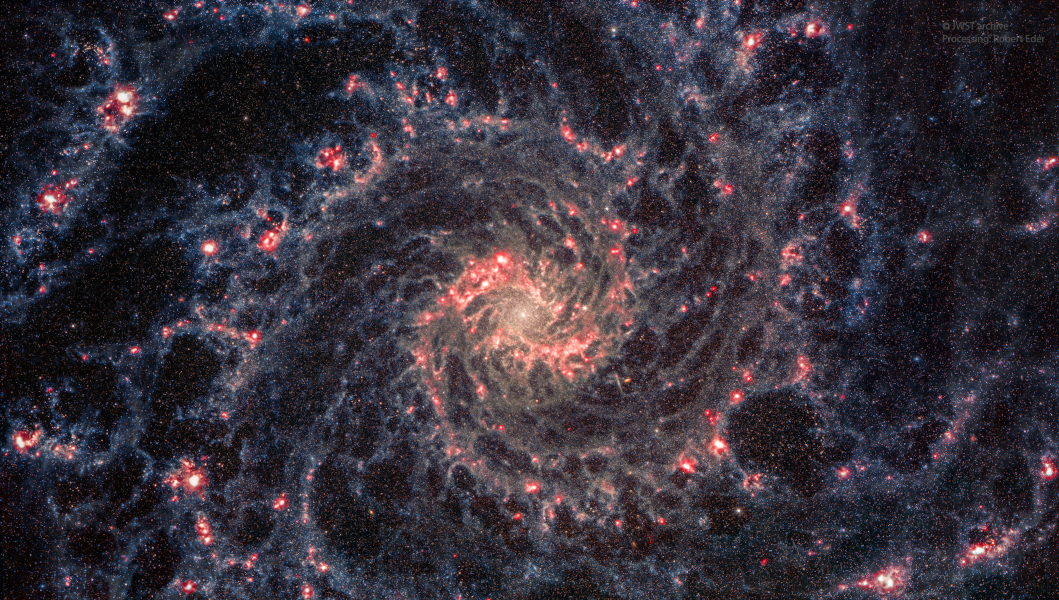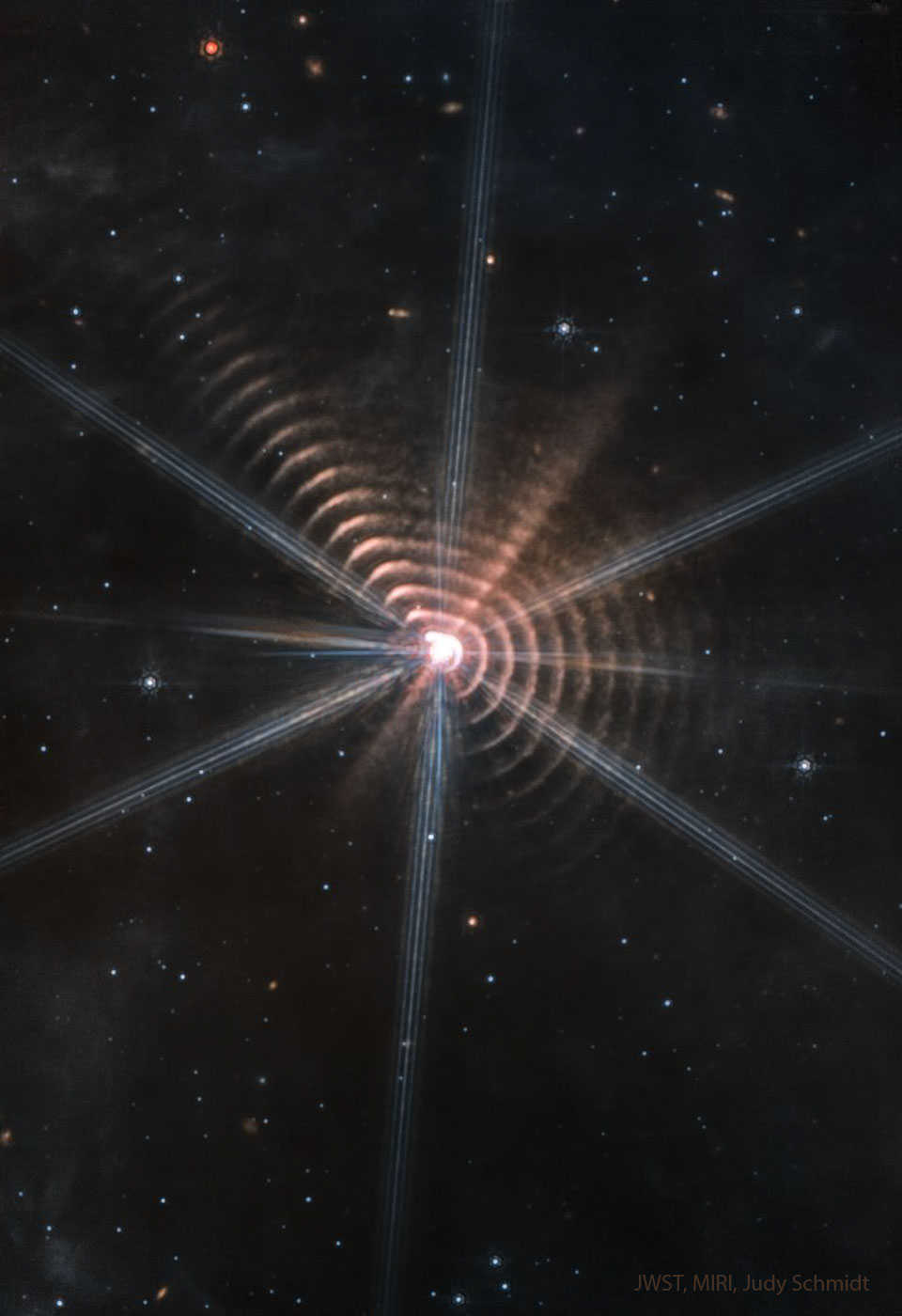Page 1 of 1
APOD_Telescopes: JWST - James Web Space Telescope
Posted: Sat Sep 14, 2024 6:33 am
by AVAO
On this channel you will find a collection of APOD's from the JWST - James Web Space Telescope.
To see the latest posts in reverse order, press this link! [/quote]
APODTJWST
Re: APOD_Telescopes: JWST - James Web Space Telescope
Posted: Sat Sep 14, 2024 7:07 am
by AVAO
2022 March 19
2MASS J17554042+6551277 doesn't exactly roll off the tongue but that's the name, a coordinate-based catalog designation, of the star centered in this sharp field of view. Fans of the distant universe should get used to its spiky appearance though. The diffraction pattern is created by the 18 hexagonal mirror segments of the James Webb Space Telescope. After unfolding, the segments have now been adjusted to achieve a diffraction limited alignment at infrared wavelengths while operating in concert as a single 6.5 meter diameter primary mirror. The resulting image taken by Webb's NIRcam demonstrates their precise alignment is the best physics will allow. 2MASS J17554042+6551277 is about 2,000 light-years away and well within our own galaxy. But the galaxies scattered across the background of the Webb telescope alignment evaluation image are likely billions of light-years distant, far beyond the Milky Way. APODTJWST
Re: APOD_Telescopes: JWST - James Web Space Telescope
Posted: Sat Sep 14, 2024 7:17 am
by AVAO
2022 July 13
This is the deepest, sharpest infrared image of the cosmos so far. The view of the early Universe toward the southern constellation Volans was achieved in 12.5 hours of exposure with the NIRCam instrument on the James Webb Space Telescope. Of course the stars with six visible spikes are well within our own Milky Way. That diffraction pattern is characteristic of Webb's 18 hexagonal mirror segments operating together as a single 6.5 meter diameter primary mirror. The thousands of galaxies flooding the field of view are members of the distant galaxy cluster SMACS0723-73, some 4.6 billion light-years away. Luminous arcs that seem to infest the deep field are even more distant galaxies though. Their images are distorted and magnified by the dark matter dominated mass of the galaxy cluster, an effect known as gravitational lensing. Analyzing light from two separate arcs below the bright spiky star, Webb's NIRISS instrument indicates the arcs are both images of the same background galaxy. And that galaxy's light took about 9.5 billion years to reach the James Webb Space Telescope. APODTJWST
Re: APOD_Telescopes: JWST - James Web Space Telescope
Posted: Sun Sep 15, 2024 6:48 am
by AVAO
2022 July 14
Cataloged as NGC 3132 the Southern Ring Nebula is a planetary nebula, the death shroud of a dying sun-like star some 2,500 light-years from Earth. Composed of gas and dust the stunning cosmic landscape is nearly half a light-year in diameter, explored in unprecedented detail by the James Webb Space Telescope. In this NIRCam image the bright star near center is a companion of the dying star. In mutual orbit, the star whose transformation has ejected the nebula's gas and dust shells over thousands of years is the fainter stellar partner. Evolving to become a white dwarf, the faint star appears along the diffraction spike extending toward the 8 o'clock position. This stellar pair's orbital motion has resulted the complex structures within the Southern Ring Nebula. APODTJWST
Re: APOD_Telescopes: JWST - James Web Space Telescope
Posted: Sun Sep 15, 2024 6:57 am
by AVAO
2022 July 18
OK, but why can't you combine images from Webb and Hubble? You can, and today's featured image shows one impressive result. Although the recently launched James Webb Space Telescope (Webb) has a larger mirror than Hubble, it specializes in infrared light and can't see blue -- only up to about orange. Conversely, the Hubble Space Telescope (Hubble) has a smaller mirror than Webb and can't see as far into the infrared as Webb, but can image not only blue light but even ultraviolet. Therefore, Webb and Hubble data can be combined to create images across a wider variety of colors. The featured image of four galaxies from Stephan's Quintet shows Webb images as red and also includes images taken by Japan's ground-based Subaru telescope in Hawaii. Because image data for Webb, Hubble, and Subaru are made freely available, anyone around the world can process it themselves, and even create intriguing and scientifically useful multi-observatory montages. APODTJWST
Re: APOD_Telescopes: JWST - James Web Space Telescope
Posted: Sun Sep 15, 2024 7:07 am
by AVAO
2022 July 20
Why does Jupiter have rings? Jupiter's main ring was discovered in 1979 by NASA's passing Voyager 1 spacecraft, but its origin was then a mystery. Data from NASA's Galileo spacecraft that orbited Jupiter from 1995 to 2003, however, confirmed the hypothesis that this ring was created by meteoroid impacts on small nearby moons. As a small meteoroid strikes tiny Metis, for example, it will bore into the moon, vaporize, and explode dirt and dust off into a Jovian orbit. The featured image of Jupiter in infrared light by the James Webb Space Telescope shows not only Jupiter and its clouds, but this ring as well. Also visible is Jupiter's Great Red Spot (GRS) -- in comparatively light color on the right, Jupiter's large moon Europa -- in the center of diffraction spikes on the left, and Europa's shadow -- next to the GRS. Several features in the image are not yet well understood, including the seemingly separated cloud layer on Jupiter's right limb. APODTJWST
Re: APOD_Telescopes: JWST - James Web Space Telescope
Posted: Sun Oct 06, 2024 3:23 pm
by AVAO
2022 July 22
Beautiful spiral galaxy Messier 74 (also known as NGC 628) lies some 32 million light-years away toward the constellation Pisces. An island universe of about 100 billion stars with two prominent spiral arms, M74 has long been admired by astronomers as a perfect example of a grand-design spiral galaxy. M74's central region is brought into a stunning, sharp focus in this recently processed image using publicly available data from the James Webb Space Telescope. The colorized combination of image data sets is from two of Webb's instruments NIRcam and MIRI, operating at near- and mid-infrared wavelengths. It reveals cooler stars and dusty structures in the grand-design spiral galaxy only hinted at in previous space-based views. APODTJWST
Re: APOD_Telescopes: JWST - James Web Space Telescope
Posted: Sun Oct 06, 2024 3:29 pm
by AVAO
2022 October 13
What are those strange rings? Rich in dust, the rings are likely 3D shells -- but how they were created remains a topic of research. Where they were created is well known: in a binary star system that lies about 6,000 light years away toward the constellation of the Swan (Cygnus) -- a system dominated by the Wolf-Rayet star WR 140. Wolf-Rayet stars are massive, bright, and known for their tumultuous winds. They are also known for creating and dispersing heavy elements such as carbon which is a building block of interstellar dust. The other star in the binary is also bright and massive -- but not as active. The two great stars joust in an oblong orbit as they approach each other about every eight years. When at closest approach, the X-ray emission from the system increases, as, apparently, does the dust expelled into space -- creating another shell. The featured infrared image by the new Webb Space Telescope resolves greater details and more dust shells than ever before. APODTJWST
Re: APOD_Telescopes: JWST - James Web Space Telescope
Posted: Sun Oct 06, 2024 5:22 pm
by Ann
AVAO wrote: ↑Sun Oct 06, 2024 3:29 pm
2022 October 13
What are those strange rings? Rich in dust, the rings are likely 3D shells -- but how they were created remains a topic of research. Where they were created is well known: in a binary star system that lies about 6,000 light years away toward the constellation of the Swan (Cygnus) -- a system dominated by the Wolf-Rayet star WR 140. Wolf-Rayet stars are massive, bright, and known for their tumultuous winds. They are also known for creating and dispersing heavy elements such as carbon which is a building block of interstellar dust. The other star in the binary is also bright and massive -- but not as active. The two great stars joust in an oblong orbit as they approach each other about every eight years. When at closest approach, the X-ray emission from the system increases, as, apparently, does the dust expelled into space -- creating another shell. The featured infrared image by the new Webb Space Telescope resolves greater details and more dust shells than ever before. [/url]. APODTJWST
Thank you, Jac, for re-posting this gorgeous image by JWST, processed by Judy Schmidt, Geckzilla!
Ann
Re: APOD_Telescopes: JWST - James Web Space Telescope
Posted: Sun Oct 06, 2024 8:36 pm
by AVAO
Ann wrote: ↑Sun Oct 06, 2024 5:22 pm
AVAO wrote: ↑Sun Oct 06, 2024 3:29 pm
2022 October 13
What are those strange rings? Rich in dust, the rings are likely 3D shells -- but how they were created remains a topic of research. Where they were created is well known: in a binary star system that lies about 6,000 light years away toward the constellation of the Swan (Cygnus) -- a system dominated by the Wolf-Rayet star WR 140. Wolf-Rayet stars are massive, bright, and known for their tumultuous winds. They are also known for creating and dispersing heavy elements such as carbon which is a building block of interstellar dust. The other star in the binary is also bright and massive -- but not as active. The two great stars joust in an oblong orbit as they approach each other about every eight years. When at closest approach, the X-ray emission from the system increases, as, apparently, does the dust expelled into space -- creating another shell. The featured infrared image by the new Webb Space Telescope resolves greater details and more dust shells than ever before. [/url]. APODTJWST
Thank you, Jac, for re-posting this gorgeous image by JWST, processed by Judy Schmidt, Geckzilla!
Ann
It is astonishing how far the shock fronts move in just 14 months - 2022-07-27 (color) and 2023-09-08 (black & white).
Simply move the mouse pointer over the image and repeat this faster and faster. Then you will notice the effect more and more clearly.
jac berne (flickr)
Re: APOD_Telescopes: JWST - James Web Space Telescope
Posted: Tue Oct 08, 2024 6:49 pm
by Ann
AVAO wrote: ↑Sun Oct 06, 2024 8:36 pm
Ann wrote: ↑Sun Oct 06, 2024 5:22 pm
AVAO wrote: ↑Sun Oct 06, 2024 3:29 pm
2022 October 13
What are those strange rings? Rich in dust, the rings are likely 3D shells -- but how they were created remains a topic of research. Where they were created is well known: in a binary star system that lies about 6,000 light years away toward the constellation of the Swan (Cygnus) -- a system dominated by the Wolf-Rayet star WR 140. Wolf-Rayet stars are massive, bright, and known for their tumultuous winds. They are also known for creating and dispersing heavy elements such as carbon which is a building block of interstellar dust. The other star in the binary is also bright and massive -- but not as active. The two great stars joust in an oblong orbit as they approach each other about every eight years. When at closest approach, the X-ray emission from the system increases, as, apparently, does the dust expelled into space -- creating another shell. The featured infrared image by the new Webb Space Telescope resolves greater details and more dust shells than ever before. [/url]. APODTJWST
Thank you, Jac, for re-posting this gorgeous image by JWST, processed by Judy Schmidt, Geckzilla!
Ann
It is astonishing how far the shock fronts move in just 14 months - 2022-07-27 (color) and 2023-09-08 (black & white).
Simply move the mouse pointer over the image and repeat this faster and faster. Then you will notice the effect more and more clearly.
jac berne (flickr)
I had trouble seeing it at first. Thanks for the suggestion to move the mouse pointer over the image faster and faster. The shock fronts are moving outwards, aren't they?
Ann
